De Qualcomm Snapdragon searjes dy't wy binne bekend mei binne net neamd neffens routines.
Wêrom soe ik nochris wat sizze?
Om't dizze kear Qualcomm it Snapdragon 8-platfoarm lansearre,
Om't it it earste-generaasje produkt is, wurdt it Snapdragon 8Gen1 neamd.

Wow dizze manier fan nammejouwing
Doe't ik it earst hearde, wie myn earste reaksje
Wat oer USB3.2 Gen2
Is it krekt itselde?
Hoewol't de nammejouwing is nuver
Mar de 8Gen1-chip
Mar in protte fan ús sjogge der nei út
Om't Snapdragon 888 dit jier net goed prestearre
Min enerzjyferbrûkferhâlding lit in protte fabrikanten fan mobile tillefoans mei ferlies
Kin de hjoeddeiske Snapdragon 8Gen1 skamje?
It flaggeskip fan Android nei in nij nivo drukke?

Litte wy efkes sjen
Earst, útlizze
Us test dizze kear is
Doch it op in masine dy't noch net útbrocht is
Dus fansels om fertinking te foarkommen
Ik kin net fertelle hokker masine it is
Hoewol't dizze masine is net opheft
Mar Snapdragon 8 Gen1 is opheft
Dat wy prate hjoed allinich oer 8Gen1
Litte wy goed sjen nei har prestaasjes en enerzjyferbrûk
foar dit
Litte wy earst de 8Gen1-arsjitektuer besjen
Ien fan 'e wichtichste feroarings yn 8Gen1 is
It is de earste dy't de nij útbrochte ARMv9 ynstruksjeset stipet

Guon audiofielen kinne it witte
Opwurdearre fan ARMv7 nei ARMv8 yn 2013
De ferbettering is enoarm

De mobyl tillefoanprosessor is direkt evoluearre fan 32-bit nei 64-bit
Apple brûkte dit ek om de kâns doe te gripen
Makke in krêftige A7 chip

Fong Qualcomm troch ferrassing
Dizze kear is ARMv9 net sa fersteurend as ARMv8

Benammen de direkte ynfloed op prestaasjes moat lyts wêze
It makke benammen wat ferbetteringen foar feiligens en skaalberens
Yn ús miening is ien fan 'e wichtichste funksjes fan ARMv9
Is de tafoeging fan de SVE2 ynstruksje set
De ARM-processors op ús mobile tillefoans yn it ferline
En de buroblêdside hat ek de ARM-prosessor op 'e superkomputer
Hoewol't se binne allegear ARM chips
Mar de breedte fan it vector register is folslein oars
De mobile telefoan chip stipet allinnich 128-bit vector lingte
It buroblêd kin 256 bits hawwe
De supercomputer-tsjinner kin 512 of sels 1024 bits berikke

Dit betsjut dat it programma jo ûntwerpe foar de supercomputer-chip
It kin net maklik rinne op in mobile telefoan
Mar na hawwen SVE2
De situaasje is oars
It brekt de boaien fan vector lingte
Untwikkelders hoege mar ien kear te kompilearjen
Jo kinne de mobile tillefoanchip en de buroblêdchip tagelyk brûke
En superkomputer kin rinne
Dat d'r kinne yn 'e takomst wat algoritmen wêze ûntworpen foar supercomputing
Jo kinne rinne op jo telefoan
om earlik te wêzen
Dit is heul foardielich foar de bou fan it ARM-ekosysteem
It kin ek sjoen wurde dat ARM de PC wol besette
Ambysje om de supercomputingmerk te besetten
Mar werom te praten oer dit foar prestaasjes
D'r sil op it stuit gjin direkte ynfloed wêze
ARMv9 is wat foar de takomst
Ferlykje prestaasjes
Ynstee dêrfan is it de nije kearn-arsjitektuer oannommen troch 8Gen1 dizze kear.
Upgrade nei Cortex-X2
China Nuclear Upgrade A710
Nucleus MINI ferfong úteinlik de A55
Opwurdearre nei de gloednije A510
Dizze X2 grutte kearn wurdt eins fergelike mei X1
De ferbettering is net sa grut
De pipeline wurdt fermindere nei 10 stadia
It bûten-oardere útfieringsfinster is wat fergrutte
Ek makke ferbetterings oan branch foarsizzing
It wichtichste is om stipe foar 32-bit programma's folslein te ferwiderjen

Dizze X2 grutte kearn is suver 64-bit
Mar yn wêzen is it noch gjin gloednije arsjitektuer
ARM's hjoeddeistige mid-core en super-grutte kearnen
Is ûntwurpen troch it Austin team
Dizze jierren binne ferbettere op basis fan A76
In wirklik fersteurend nij kernelûntwerp
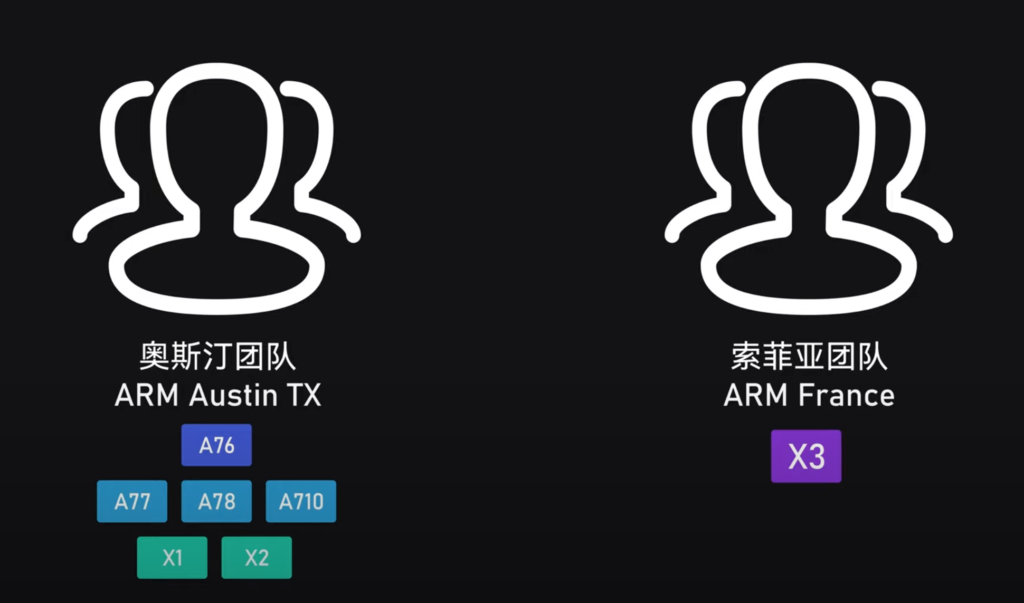
It’s not until next year that the Sophia team will bring
So I actually look forward to the performance of X3 next year
Including the new Cortex-A710
Compared with Cortex-A78, there will not be much performance improvement
But from ARM’s PPT
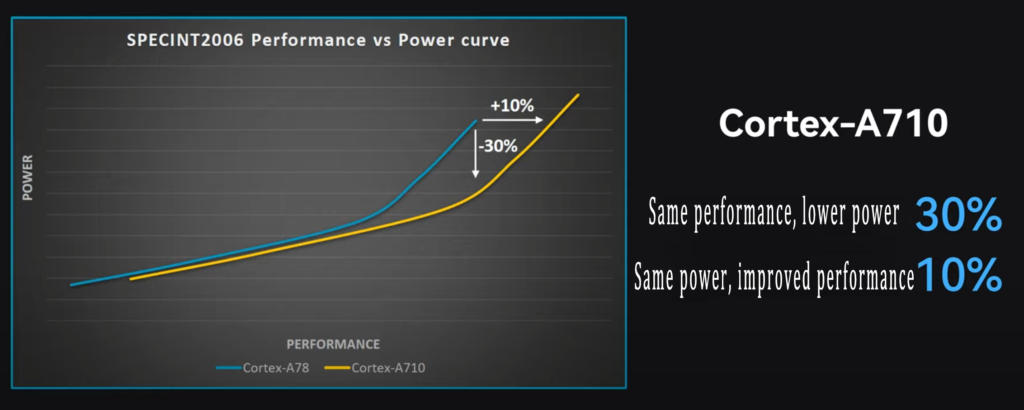
Power consumption seems quite worth looking forward to
Cortex-A710 has a very special place
It is the only one that retains 32-bit support among the three cores
According to ARM, it is specifically considered for the Chinese market
Because there are still a lot of 32-bit software in China
So need a little transition period
OK
The most worth talking about among the three cores
It’s actually a small core A510
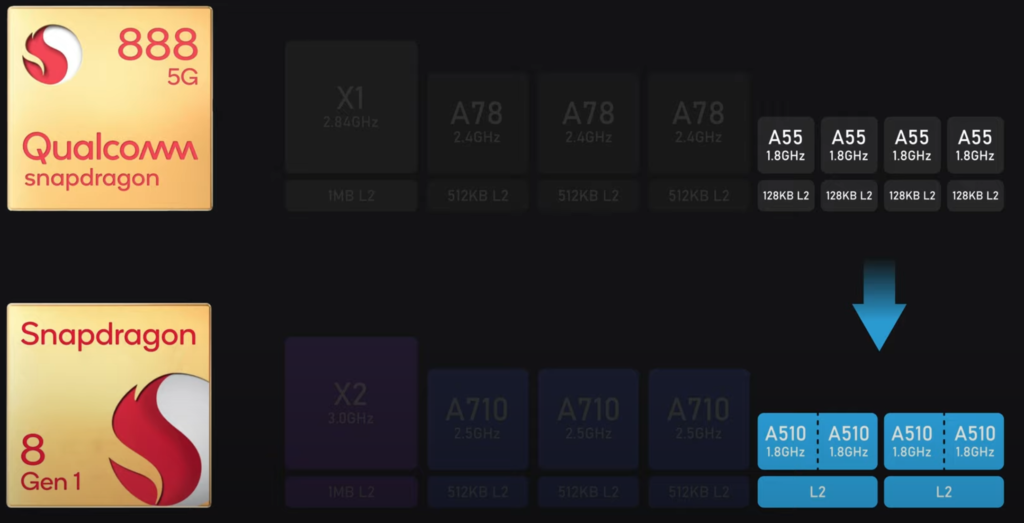
A510 is the ARM Cambridge team
The core of a completely new design
Finally eliminated Wannian A55
Prestaasje neffens de ferklearring fan ARM
Kin 35% oant 50% sterker wêze as A55 IPC

De foarútgong is yndie dúdlik
Mar dizze ferbettering komt benammen troch ferbreding en tanimmen
Bygelyks, upgrade nei 3 dekodearrings 3 lansearring
3 groepen ALU oan 'e efterkant
De enerzjyferbrûkferhâlding is dus eins net folle ferbettere
Jo kinne sizze dat dizze A510 is folle sterker
Mar net needsaaklik enerzjybesparring

De meast krityske
It is noch altyd in sekwinsjele útfieringsprosessor
Dus noch grutter is it ornearre om in lytse kearn te wêzen
Mar A510 hat in hiel bysûndere design
Elke kearn sels is net kompleet
Mar om in kluster te foarmjen mei twa kearnen

Dielde L2-cache en driuwend-punt diel
Dit is in bytsje as it ûntwerp fan AMD op in bulldozer
De bulldozer wie miserabel troch dit ûntwerp.
Mar ik tink dat it hiel passend is om it hjir A510 te setten
Fanwege lytse kearnen lykas dit
Faker wurdt it brûkt om eftergrûnwurk te behanneljen
Integer oproppen binne yndie signifikant faker
Floating point is eins net heul nuttich
Dat ik begryp dit dielde ûntwerp
Teoretysk kin ferbetterje effisjinsje
Ik bin frij nijsgjirrich nei de prestaasjes fan dizze A510
Net allinich de grutte, middelgrutte en lytse kearnen binne ferfongen troch nije arsjitektuer
De L3-cache fan 8Gen1 is ek grutter dan 888
Fan 4M oant 6M

Mar 6M is noch altyd net fol bloed
Folslein bloed is 8M
Caching hat normaal in grutte ynfloed op it spultsje
Helpt dizze ferbettering?
It antwurd wurdt letter iepenbiere
8Gen1 liket in fuortsetting te wêzen fan 888+ op CPU fêste frekwinsje
De grutte kearn wurdt lutsen nei 3GHz yn ferliking mei 888
Considering the frequency set by Dimensity 9000 next door

I think Qualcomm is still slightly conservative
But the manufacturing process
8Gen1 still uses
Samsung craftsmanship that everyone is very familiar with
Although upgraded to 4nm
But this is also improved from 5nm
Everyone can see what Samsung 5nm is
So what is the energy consumption ratio?
I still care very much
But what I care about most is actually the GPU part
Different from CPU

8Gen1’s GPU changes are still great
Finally eliminated the Adreno 600 series that had been used for 4 years

Upgraded to Adreno 730
GPU of the previous Android camp
Already behind the iPhone too much
So I am looking forward to the performance of Qualcomm’s new GPU.
What are its performance and power consumption
We’ll find out later
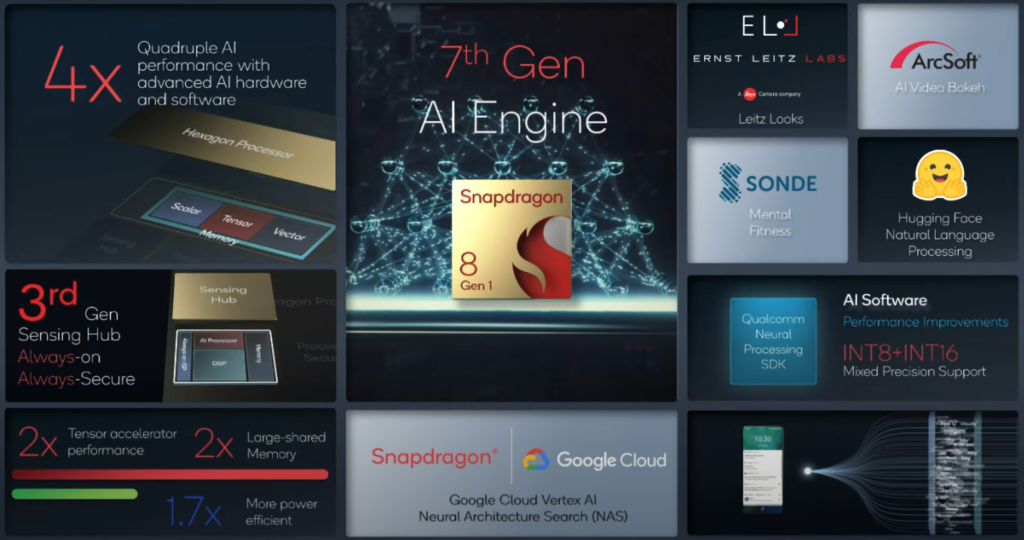
Other than that
The AI unit of 8Gen1 has also been greatly improved
ISP part of the upgrade is also very big

Can shoot 18-bit images
The tolerance is much higher than 888’s ISP
The baseband has also been upgraded to X65
Downlink speed can reach 10 Gigabit
It’s a big improvement
Look at it this way
This 8Gen1 seems to be inside and out
I changed everything
It’s really not as simple as changing the name
The change is quite big
But is its performance worthy of this new name?
We still have to take a good test and see
First of all, CPU performance is still the focus of our concern
So look directly at Geekbench 5

What is the situation with this CPU of 8Gen1?
3810 multi-core points
Only 60 points higher than 888
It’s just a 1.5% improvement.
Are you joking?
All big, medium, and small cores have been replaced
The result is a difference of 1.5%?
The single-core performance is also terrible
1200 points are also only 60 points better than 888
Increased by 5.7% only

Basically this single core of Snapdragon 8Gen1
Still does not exceed the A13 level
Considering the X2 core of 8Gen1
It’s already 3.0GHz
It has a higher frequency than 888’s X1
It’s not difficult to see that the X2 core is also a bit like squeezing toothpaste
Then the problem is coming
Single-core boost is limited
Multi-core performance is almost in place
Can your power consumption be optimized?
Unfortunately not
Snapdragon 8Gen1 CPU power consumption in GB5
Even higher than 888
Single-core 4.2W multi-core 11.1W
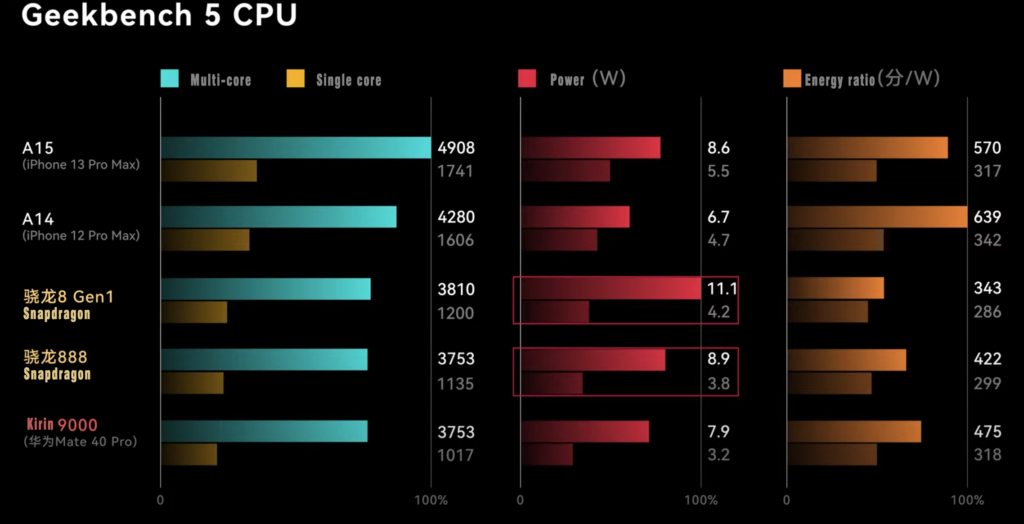
Do you want to keep the power consumption on par with the notebook?
It can be described as an electric tiger
Even if you look at the detailed power consumption curve we measured
Some projects can already reach 14W

This is horrible
With almost no improvement in multi-core performance
Power consumption can actually be higher than 2.2W
Isn’t this amazing?
I think one aspect is
We have been waiting for this new small core A510 for a long time
Completely disappointed our expectations
Performance
It didn’t bring much improvement in the energy consumption ratio.
On the other hand, the energy efficiency performance of Samsung’s 4nm process is still not optimistic.
Besides
8Gen1 also adds 2M level three cache
This may also bring a little power consumption
Of course, the three-slow improvement is actually not easy to reflect in the results of GB5
I can look forward to its effects when the game is tested later.
Anyway, the CPU part of 8Gen1
The Peak energy consumption ratio is quite bad
This CPU disappoints us a bit
But I also said before
What I am more looking forward to is the 8Gen1 GPU
How is the performance of this GPU?
Let’s run GFXBench and see
Hey wait a minute, what’s the situation?
Is this GPU better than A14?
No, 8Gen1 is even close to this GPU
Youth version A15

Qualcomm
This is something!
This is just OpenGL
Let’s run the Vulkan test again
Can already kill the residual blood A15
This GPU is pretty good
It’s almost 60% stronger than 888

Too scary
It seems that although Qualcomm has pulled a hand on the CPU
But the GPU did not neglect at all
Not bad
The performance of the new architecture of Adreno 700 is quite impressive
But your GPU is so powerful
Almost catching up with the A15 level
If the power consumption is not high
Isn’t it just hanging Apple?
So beautiful
Because the 8Gen1 GPU
Peak power consumption is higher than its CPU
When the performance of this GPU reaches the residual blood A15
Power consumption soared to 11.2W

Much higher than A15
The GPU power consumption is even close to M1
It is the mobile GPU with the highest peak power consumption we have ever tested
High-performance explosion, high power consumption explosion
That such a super large nuclear bomb GPU
Can you withstand the test of the baking machine?
We open the bright mountains
Run a durability test
8Gen1 seems to be doing pretty well here
The peak can already reach the level of A15
And here the down-frequency curve
It is smoother than the iPhone
But obviously such a big nuclear bomb
It’s impossible if you don’t want to reduce the frequency
Run down the Guangming Mountain in 10 minutes
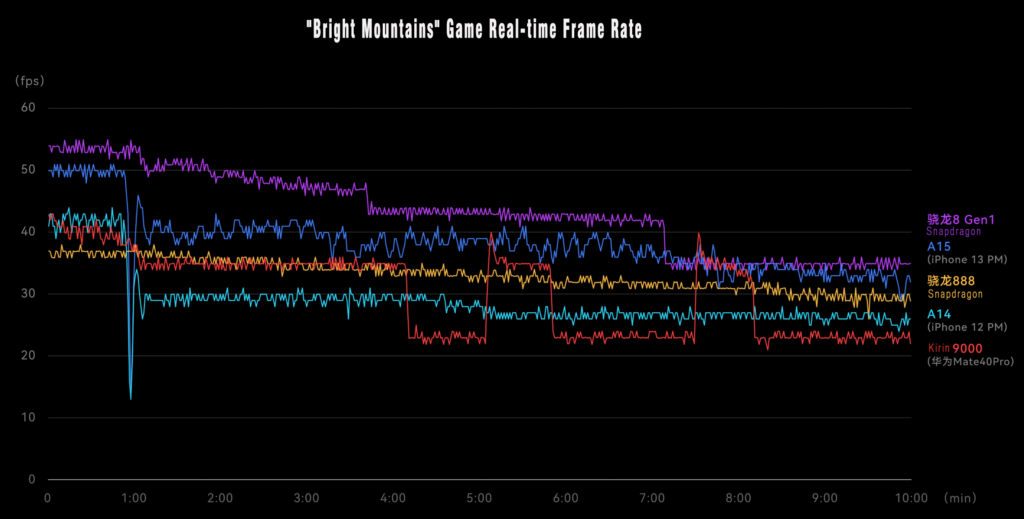
Probably will drop to the peak performance of 888
If we put more pressure on the GPU
Run longer
Run the 3DMark Wild Life Extreme stress test
Will eventually get 66.8% stability
Frequency reduction is quite serious
Although think about the good
Even if the GPU is completely reduced in frequency
Still better than the peak of 888

But this is obviously not a particularly energy-saving achievement
It seems that mobile phone manufacturers want to suppress 8Gen1 GPU
Still have to spend a lot of effort on heat dissipation
Although the peak GPU power consumption has exploded
But mobile phones don’t only have peak power consumption, right?
Now that I have changed to a new GPU architecture
Then you always have to improve the energy consumption ratio of some architectures.
I’m very curious
It’s under a slightly lower graphics load
If we reduce the load
How about the energy consumption ratio?
To test this
We designed a new project
Is the fixed load test of the Bright Mountains
We reduced the resolution to 1080P

Then run at 30 FPS
Simulate a slightly lower and uniform GPU load
Let’s take a look at the power consumption performance of these mobile GPUs under the same load
The result is this GPU of Snapdragon 8 Gen1
Medium load power consumption is not low

It is only slightly better than the most garbage 888
Compared to the 865, it’s still driving backward.
Co-author of the improvement of your architecture’s energy consumption ratio
In the end, it was all offset by Samsung craftsmanship?
This is an intermediate frequency performance
Many actual games will be close to this load
You said that if you just explode in peak load, it is excusable
Is the running score as strong as a tiger?
But if the game load is so bad
Then really don’t have to mix
This energy consumption ratio is just a joke
Mar dit binne allegear teoretyske tests
Yn it eigentlike spultsje
Wat sil de prestaasjes fan 8Gen1 wêze?
Wy noegje ús âlde freon noch út - de oarspronklike god

De rûte is noch altyd ús tradisjonele nachtrinnekaart fan Liyue Port
As jo prate oer CPU druk
Liyue Port is noch heger as de ôfgrûn
Benammen om't it faak laden hjir hege easken stelt oan I/O
It platfoarm dat in bytsje tichtby is is maklik te befriezen
Sa brûke wy dizze test noch
Foardat jo de test útfiere
Noch yn oerienstimming mei ynternasjonale praktyk
Ik wit net oft it de reden is wêrom't it nije platfoarm net oanpast is
De oarspronklike god liket op 8Gen1 te wêzen
Op it stuit is de heechste renderingsresolúsje 640P
Net standert 720P
Itselde as doe't wy 888 testen
But the image quality in the medium seems to be the same as other Android devices
Both are 568P resolution
Then our test is still the same as before
Divided into three types of loads
wifi+ medium picture quality medium load
wifi+highest picture quality 300 nits screen with high load
And 5G network + highest picture quality + 30 degrees room temperature devil load
To be reasonable
It’s not easy
First of all, look at the high load
That is, the highest quality wifi test
If you just watch the first 3 minutes
The performance of 8Gen1 seems to be pretty good
Although I only have 3 minutes

It’s almost a thread running at 60 frames
This has never been achieved on previous Qualcomm models
Check the frequency and you will find
The CPU scheduling in this section is also more aggressive
Therefore, the power consumption at this time is also relatively high
Will reach 7.6W of the whole machine
Obviously, this won’t last long
So after 3 minutes, the CPU will start to reduce the frequency one after another
Actually ran down for a 30-minute test
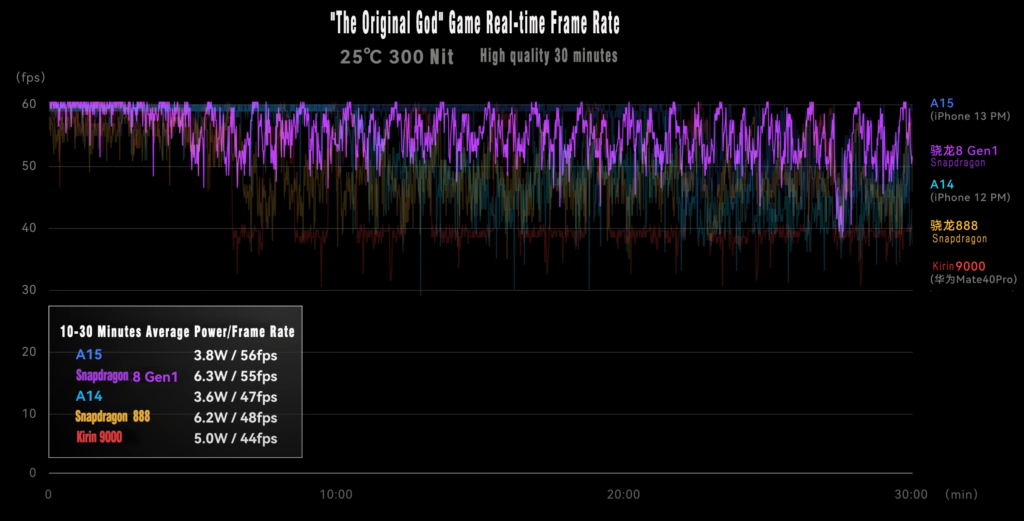
The final average number of frames will fall around 55 frames
The power consumption of the whole machine will be controlled at about 6.3W
In terms of power consumption, it is not lower than the 888 model.
But the number of frames has indeed increased
The game is smoother than 888
Some students will feel
Is this the credit of the GPU?
After all, this time the GPU is so strong
I don’t think it’s
You see, the GPU occupies only 56% on average
GPU load is very low
The improvement of the original god’s performance
I think it is the third level cache
6M three slow is really in the game

Greatly alleviated the CPU bottleneck
Look at it this way
Even if the CPU score and 888 can’t make the gap
But the performance of 8Gen1 in the actual game is pretty good
Of course, it’s a long way from Apple
But if your body can hold down for a long time
7.6W overall power consumption
The original god can indeed maintain full-frame operation
This is something that 888 can’t do even with a low resolution.
But I still want to remind everyone that this is only the performance of 640P now
720P GPU load will be higher
So the power consumption of the whole machine will be higher
Another concern is the body temperature
This phone runs for 30 minutes, the original god queen
The hottest spot is on the border
Can reach above 48 °c
Considering that the power consumption of this chip is still relatively high
This warm The performance is expected
Of course, the temperature of the phone also depends on your model
Let’s talk about high EQ
This generation of Qualcomm platform with the help of the heat dissipation carapace
The original god’s performance is very good
We also tried to reduce the image quality to medium quality
Unified 568P resolution
Running load test
The original god can indeed persist for a longer time to maintain the full-frame
About 6 minutes
In the future, there will still be slow frequency reduction
Nei 30 minuten kin it lykwols noch gemiddeld 57 frames hâlde.
De fluggens is yndie better as it 888-model
It is spitich dat dit enerzjyferbrûk
It is noch sawat itselde as 888
Úteinlik
Ik leau dat jo net kinne wachtsje om de test fan 'e duvel te sjen.
Wy brûke 5G mobyl netwurk, 30 graden keamertemperatuer, 300 nits skerm
Spielje de orizjinele god mei de heechste byldkwaliteit
Baseband-prosessor en skerm waarmje tegearre op
Litte wy it potensjeel fan dizze tillefoan folslein squeeze
Unferwachts ûnder dizze lading
8Gen1 rûn út it heechste nivo fan alle modellen

Gemiddeld 48 frames
Hoewol yn dizze steat
De heechste oerflaktemperatuer fan 'e tillefoan hat 53 graden oerschreden
Fansels is it te waarm om te hâlden
Mar it goede nijs is dat it teminsten net crashte
The number of game frames is also very stable
There is no drop to more than ten frames
Of course, this is also related to the heat dissipation of the model we are using
Anyway, the performance of this devil test is pretty good
In addition to CPU and GPU
We also tested the AI performance of NPU
Qualcomm replaced NPU on 8Gen1
Let’s measure the results of Geekbench ML

Compared to 888, the improvement is very obvious
However, there is still a certain gap with the industry benchmark A15
Of course, the main reason for this is
888’s AI performance is too bad
Not even as good as Dimensity 1200
Anyway, the AI performance of 8Gen1 is still qualified
In general
The results of this Snapdragon 8Gen1 test are mixed.
On the bright side
It brings us extremely terrifying GPU performance
The GPU of the Android camp can finally catch up with Apple’s pace
The increased three slowdowns of the CPU also make the original god run more smoothly
But the bad side
Peak power consumption is still very explosive
Sustained energy consumption is better than at most, which is better than 888
Still not so good
And the CPU improvement is too small
Minimal progress at the architectural level
I think the performance of Snapdragon 8Gen1
It’s definitely not a shame
But considering the GPU progress is indeed very large
So how can I give it a comment
It’s even higher than the useless 888
So it seems
The situation of 8Gen1 is a bit like the Snapdragon 820 back then.
We still hope that the next generation can have a 835 reincarnation.
All right
Today we tested the performance of Snapdragon 8Gen1 in more detail
I wonder if this 8Gen1 symbol does not meet your expectations?
To be honest, it was quite unexpected
I didn’t expect any CPU improvement
Power consumption is also a bit unexpected
But the GPU has improved so much
I didn’t expect
It should be said that this generation of game performance
It will largely depend on the cooling performance of the phone
Then the data of the Snapdragon 8Gen1 chip
We have also been included in the socpk ranking
Probably ranked here
Close to A14
Students who want to see us summarize detailed data
Welcome to socpk.com to check
See you next time bye












